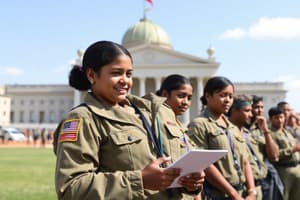Podcast
Questions and Answers
What requirement is specified for State Universities and Colleges (SUCs) regarding the NSTP components?
What requirement is specified for State Universities and Colleges (SUCs) regarding the NSTP components?
- They are allowed to exclude ROTC if they meet certain criteria.
- They can choose to offer only non-military training components.
- They shall offer at least the ROTC component and one other component. (correct)
- They must offer all NSTP components without exception.
Which institutions are exempt from the NSTP requirements?
Which institutions are exempt from the NSTP requirements?
- All private universities with ROTC programs.
- Any university that decides to focus only on civilian training.
- Institutions such as the PMA and PNPA based on their special character. (correct)
- Technical-vocational education institutions with fewer than 350 students.
What is the minimum academic period required for each NSTP component?
What is the minimum academic period required for each NSTP component?
- One semester
- Two semesters (correct)
- Three semesters
- Four semesters
What are the components available in the NSTP that students can choose from?
What are the components available in the NSTP that students can choose from?
Which of the following statements about the implementation of NSTP components is accurate?
Which of the following statements about the implementation of NSTP components is accurate?
What is the primary focus of the Literacy Training Service (LTS)?
What is the primary focus of the Literacy Training Service (LTS)?
Which component of the NSTP is aimed at improving the overall welfare of the community?
Which component of the NSTP is aimed at improving the overall welfare of the community?
What does the term 'Cross Enrollment' refer to in the context of NSTP?
What does the term 'Cross Enrollment' refer to in the context of NSTP?
What is the purpose of the Reserve Officers’ Training Corps (ROTC)?
What is the purpose of the Reserve Officers’ Training Corps (ROTC)?
Which of the following is NOT a defined program component of the NSTP?
Which of the following is NOT a defined program component of the NSTP?
Flashcards are hidden until you start studying
Study Notes
NSTP Program Components
- Literacy Training Service (LTS) focuses on teaching literacy and numeracy skills to children, youths and underprivileged segments of society.
- Civic Welfare Training Service (CWTS) focuses on community welfare activities that enhance the quality of life in areas like health, education, environment, entrepreneurship, safety, recreation, and social welfare.
- Reserve Officers' Training Corps (ROTC) focuses on military training to prepare students for national defense. It implements Section 38 and 39 of Republic Act No. 7077.
Program Implementation
- All incoming freshmen students (male and female) in baccalaureate and two-year technical-vocational or associate courses must complete one NSTP component.
- All higher education institutions, including State Universities and Colleges (SUCs) and technical-vocational education institutions, must offer the three NSTP components.
- State Universities and Colleges (SUCs) must offer the ROTC component and at least one other NSTP component.
- The Philippine Military Academy (PMA), Philippine Merchant Marine Academy (PMMA), and Philippine National Police Academy (PNPA) are exempt from the NSTP. Other State Universities and Colleges with similar nature may be exempted with Department of National Defense approval.
- Private Higher Educational Institutions (HEIs) and technical vocational education institutions with at least 350 student cadets may offer the ROTC component and establish a Department of Military Science and Tactics (DMST) subject to the existing rules and regulations of the Armed Forces of the Philippines (AFP).
Program Duration & Units
- Each NSTP component is undertaken for two semesters.
- Each semester is credited for three units with 54 to 90 training hours.
- A One Summer Program (OSP) may be adopted by the DND, CHED, and TESDA, subject to the school's and AFP's capability to handle it.
Clustering and Cross-Enrollment
- Clustering of students from different institutions for semestral or summer periods can be done. The host school manages the program.
- Schools that do not meet the student requirements to maintain the ROTC or other NSTP components allow students to cross-enroll with other schools, regardless of CHED or TESDA accreditation.
- Students intending to cross-enroll are subject to the rules and regulations of both schools.
Management & Monitoring
- Schools have academic and administrative supervision over the NSTP components.
- For ROTC, school authorities and DND share supervision, subject to DND's policies and regulations.
- Schools collaborating with CHED-accredited or TESDA-recognized NGOs share supervision over training modules.
National Service Reserve Corps
- CHED, TESDA, and DND collaborate with other government and non-government agencies to establish the National Service Reserve Corps.
- ROTC graduates become part of the Citizen Armed Force, subject to DND requirements.
Transitory Provisions
- Students who completed all academic requirements by March 23, 2002, are exempt from ROTC.
- Male students not covered by the previous exemption and currently enrolled who have not taken Military Service (MS), Civil Welfare Service (CWS), or Law Enforcement Service (LES) programs are covered by the NSTP law.
- Male students who completed two semesters of Expanded ROTC (E_ROTC)/ National Service Program (NSP) have fulfilled the NSTP requirement.
- Male students who completed one semester of Basic ROTC or EROTC/NSP must take one more semester of an NSTP component.
- Students interested in Reserve Force enlistment or advanced ROTC must participate in a special program.
Information Dissemination
- CHED, TESDA, and DND disseminate information about the NSTP Act and Implementation Rules through various channels.
Amendatory Clause
- Commonwealth Act No. 1, Executive Order No. 207 of 1939, Presidential Decree No. 1706, and Republic Act No. 7077, and other inconsistent laws, are superseded by the NSTP Act.
- CHED, TESDA, and DND, in consultation with PASUC, COCOPEA, NGOs, and recognized student organizations, can amend, modify, or replace the Implementation Rules.
Effectivity
- These Implementation Rules are effective immediately upon adoption and issuance.
Studying That Suits You
Use AI to generate personalized quizzes and flashcards to suit your learning preferences.




